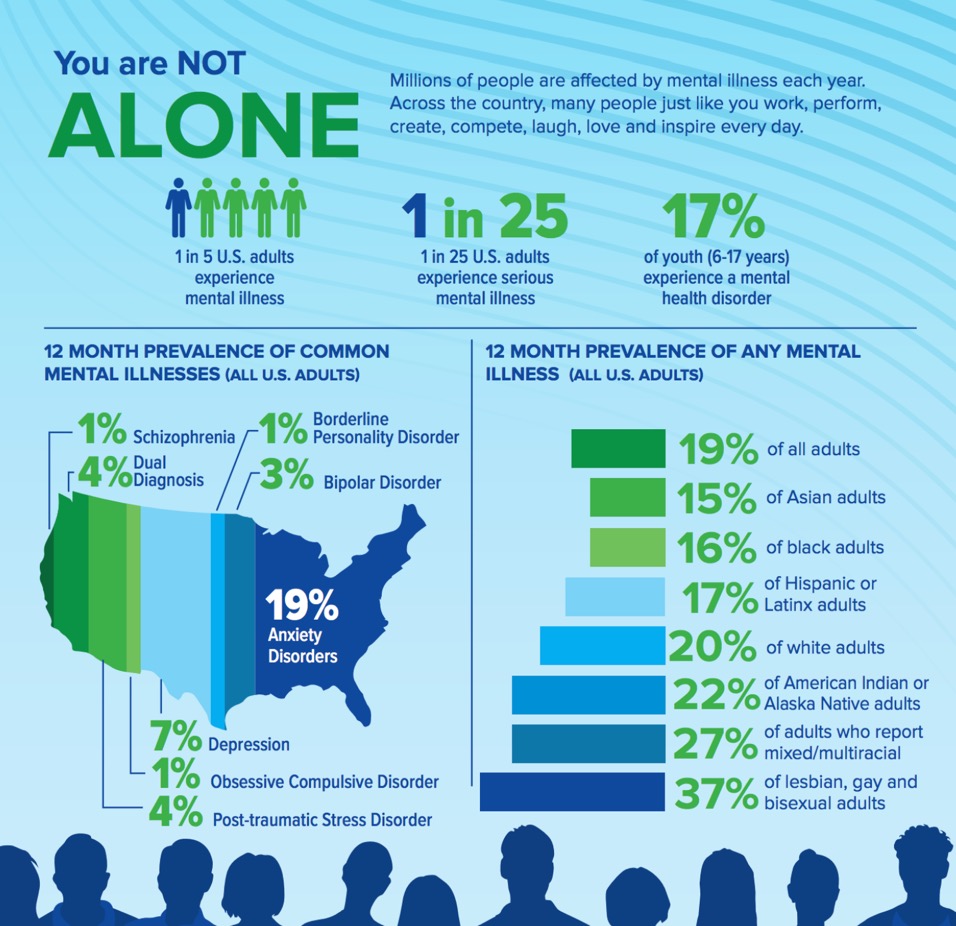
Impact on Adults
- 1 in 5 U.S. adults experience mental illness each year
- 1 in 25 U.S. adults experience serious mental illness each year
- 19.1% of U.S. adults experienced mental illness in 2018 (47.6 million people). This represents 1 in 5 adults.
- 4.6% of U.S. adults experienced serious mental illness in 2018 (11.4 million people). This represents 1 in 25 adults.
- 3.7% of U.S. adults experienced a co-occurring substance use disorder and mental illness in 2018 (9.2 million people)
- People with depression have a 40% higher risk of developing cardiovascular and metabolic diseases than the general population. People with serious mental illness are nearly twice as likely to develop these conditions.
- 19.3% of U.S. adults with mental illness also experienced a substance use disorder in 2018 (9.2 million individuals)
- The rate of unemployment is higher among U.S. adults who have mental illness (5.8%) compared to those who do not (3.6%)
Annual prevalence among U.S. adults, by condition:
- Major Depressive Episode: 7.2% (17.7 million people)
- Schizophrenia: <1% (estimated 1.5 million people)
- Bipolar Disorder: 2.8% (estimated 7 million people)
- Anxiety Disorders: 19.1% (estimated 48 million people)
- Posttraumatic Stress Disorder: 3.6% (estimated 9 million people)
- Obsessive Compulsive Disorder: 1.2% (estimated 3 million people)
- Borderline Personality Disorder: 1.4% (estimated 3.5 million people)
Impact on Youth
- 1 in 6 U.S. youth aged 6-17 experience a mental health disorder each year
- 50% of all lifetime mental illness begins by age 14, and 75% by age 24
- Suicide is the 2nd leading cause of death among people aged 10-34
- 16.5% of U.S. youth aged 6-17 experienced a mental health disorder in 2016 (7.7 million people)
- High school students with significant symptoms of depression are more than twice as likely to drop out compared to their peers
Impact on Families
- At least 8.4 million people in the U.S. provide care to an adult with a mental or emotional health issue
- Caregivers of adults with mental or emotional health issues spend an average of 32 hours per week providing unpaid care
Impact on our Communities
- Mental illness and substance use disorders are involved in 1 out of every 8 emergency department visits by a U.S. adult (estimated 12 million visits)
- Mood disorders are the most common cause of hospitalization for all people in the U.S. under age 45 (after excluding hospitalization relating to pregnancy and birth)
- Across the U.S. economy, serious mental illness causes $193.2 billion in lost earnings each year
- 20.1% of people experiencing homelessness in the U.S. have a serious mental health condition
- 37% of adults incarcerated in the state and federal prison system have a diagnosed mental illness
- 70.4% of youth in the juvenile justice system have a diagnosed mental illness
- 41% of Veteran’s Health Administration patients have a diagnosed mental illness or substance use disorder
Impact on Our Diverse Communities
Annual prevalence of serious thoughts of suicide, by U.S. demographic group:
- 4.3% of all adults
- 11.0% of young adults aged 18-25
- 17.2% of high school students
- 47.7% of lesbian, gay, and bisexual high school students
- Lesbian, gay and bisexual youth are 4x more likely to attempt suicide than straight youth
- 75% of people who die by suicide are male
- Transgender adults are nearly 12x more likely to attempt suicide than the general population
Annual prevalence of mental illness among U.S. adults, by demographic group:
Information reported by NAMI National. Some information on this page comes from studies conducted by organizations like Substance Abuse and Mental Health Services Administration (SAMHSA), Centers for Disease Control and Prevention (CDC) and the U.S. Department of Justice.
newsletter
NAMI Westside Los Angeles
Nurturing young minds. Subscribe to our newsletter for fun activities, parenting tips, and resources to support children's growth and development.


